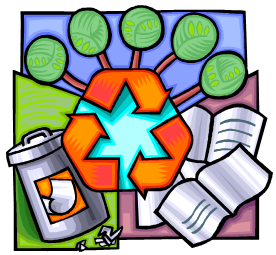
Renewable
Energy Sources:
Wind, Solar and Geothermal
This unit will explore
renewable energy sources. You will learn about our current usage of renewable
fuels and how they must be changed and adapted for our use. You will also
discover the advantages and disadvantage of renewable energy sources. A
discussion of the future of these alternative energy sources is included.
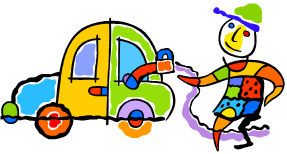 Scientists are working hard to find new ways to meet
the worldís ever expanding need for energy.†
Look at the sources of energy we use today.† Mostly we depend upon gas, oil, and coal,
fossil fuels.† The electricity in your
house probably is generated at a power plant that relies heavily on coal.† Our cars run on gas and we heat out homes
with gas or oil or electric generated by coal.
Scientists are working hard to find new ways to meet
the worldís ever expanding need for energy.†
Look at the sources of energy we use today.† Mostly we depend upon gas, oil, and coal,
fossil fuels.† The electricity in your
house probably is generated at a power plant that relies heavily on coal.† Our cars run on gas and we heat out homes
with gas or oil or electric generated by coal.
We found in the last unit how
long it took fossil fuels to form.† Since
these fossil fuels are nonrenewable resources we only have a limited amount to
use.† Some scientists predict that
without decreasing our usage of fossil fuels they could be gone in as few as
100 years.†
It is not hard to figure out
that the world is simply not going to stop using energy so the solution is to
find energy sources that are not limited, but renewable.† In this lesson we will look at various types
of renewable energy sources.† These are
not new energy sources.† People all over
the world have been using them for a very long time.† Each source will have advantages, but also
come with disadvantages. We will look at the availability of the source.† We will look at the advantages and the
disadvantages. Understanding all these parts together will help us make good
decisions of how to use these sources for our energy needs.
†
Scientists will use problem
solving to deal with the disadvantages and try to find solutions.† The future is promising.† Many new methods of energy generation are
being tested, used and refined, not only in industry but in communities across
the country.†† Some ideas are passive
while other ideas are very complex.† Read
on to find out how alternative energy sources can help work out the shortage of
energy.†
Fuel Facts
ō
In 1850 91% of
the US energy came from wood, a renewable resource, today 90% of the US energy
comes from nonrenewable fossil fuels
Solar Energy
We have always used the energy of the sun
as far back as humans have existed on this planet. Five thousand years ago,
people "worshipped" the sun. Ra, the sun-god, was considered the
first king of Egypt.

We know today, that the sun
is simply our nearest star. Without it, life would not exist on our planet. We
use the sun's energy every day in many different ways. When we hang laundry outside
to dry in the sun, we are using the sun's heat to do work -- drying our
clothes.
Plants use the sun's light to
make food. Animals eat plants for food. Decaying plants hundreds of millions of
years ago produced the coal, oil and natural gas that we use today. So, fossil
fuel is actually sunlight stored millions and millions of years ago.

Indirectly, the sun or other
stars are responsible for ALL our energy. Even nuclear energy comes from a star
because the uranium atoms used in nuclear energy were created in the fury of a
nova - a star exploding.

Let's look at ways in which we can
use the sun's energy.
∑
Solar Hot Water
o
In the 1890s
solar water heaters were being used all over the United States. They proved to
be a big improvement over wood and coal-burning stoves. Gas was available to
heat water, but it was very, very expensive. And electricity was even more
expensive.† Some towns did not even have
electricity.
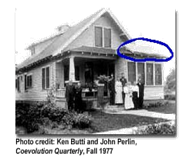
o
The picture shown
here, on the right, is a solar water heater installed on the front roof of a
house in California; in 1911 (the panels are circled above the four windows).
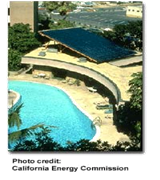 Improvements were made on solar heating systems in
Arizona, Florida and many other sunny parts of the United States. By 1920, ten
of thousands of solar water heaters had been sold.† Then large deposits of oil and natural gas
were discovered in the western United States.†
The cost of fuel became very low.†
Solar water systems began to be replaced with heaters that burned fossil
fuels.†† Today, solar water heaters are
making a comeback. They heat water for use inside homes, businesses and
swimming pools.
Improvements were made on solar heating systems in
Arizona, Florida and many other sunny parts of the United States. By 1920, ten
of thousands of solar water heaters had been sold.† Then large deposits of oil and natural gas
were discovered in the western United States.†
The cost of fuel became very low.†
Solar water systems began to be replaced with heaters that burned fossil
fuels.†† Today, solar water heaters are
making a comeback. They heat water for use inside homes, businesses and
swimming pools.
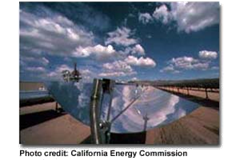 Solar Thermal Electricity
Solar Thermal Electricity
Solar energy can also be used
to make electricity. Some solar power plants use a curved mirror to focus the
sunlight on a pipe running down a midpoint above the curve of the mirror. The
mirror focuses the sunlight to strike the pipe, and it gets so hot that it can
boil water into steam. That steam can then be used to turn a turbine to make
electricity.
The problem with solar energy is that it works only
when the sun is shining. So, on
cloudy days and at night, the power plants can't create energy.
Scientists are working to
solve this disadvantage.† They canít make
the sun shine but they can use a "hybrid" technology. During the
daytime they use the sun. At night and on cloudy days they burn natural gas to
boil the water so they can continue to make electricity.
There are many other types of solar power plants being tested. Scientists say some types of larger solar power plants can make electricity for 100,000 to 200,000 homes.
Solar Cells or Photovoltaic Energy
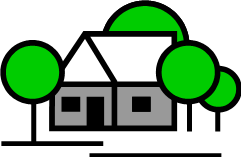
We can also change the
sunlight directly to electricity using solar cells. These are like sunshine
batteries.† The energy is stored in the
cells or batteries but the energy comes from the sun, not a chemical reaction
like in the AA Energizers in your walkman.

Solar cells are also called
photovoltaic cells - or PV cells for short and can be found on many small
appliances, like calculators, and even on spacecraft. They were first developed
in the 1950s for use on U.S. space satellites.
The electrical energy from
solar cells can then be used directly. It can be used in a home for lights and
appliances. It can be used in a business. Solar energy can be stored in
batteries to light a roadside billboard at night. Or the energy can be stored
in a battery for an emergency roadside cellular telephone when no telephone
wires are around.
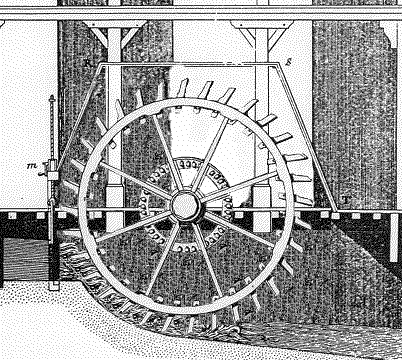 Hydro Power
Hydro Power
When it rains in hills and
mountains, the water becomes streams and rivers that run down to the ocean. The
moving or falling water can be used to do work. Energy, you'll remember is the
ability to do work. So moving water, which has kinetic energy, can be used to
make electricity.
For hundreds of years, moving water was used
to turn wooden wheels to grind (or mill) flour or corn. These were called grist
mills or water mills. Water can either go over the top of the wheel, or the
wheel can be placed in the moving river. The flow of the river then turns the
wheel.
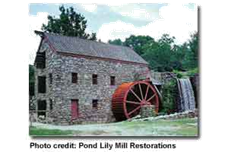 In 1086 in southern England there were 5,624
waterwheel-driven mills. That was about one mill for each 400 people.†† Today, moving water can also be used to make
electricity.†† Hydro means water.
Hydro-electric means making electricity from water power.
In 1086 in southern England there were 5,624
waterwheel-driven mills. That was about one mill for each 400 people.†† Today, moving water can also be used to make
electricity.†† Hydro means water.
Hydro-electric means making electricity from water power.
Hydroelectric power uses the
kinetic energy of moving water to make electricity. Dams can be built to stop
the flow of a river. Water behind a dam sometimes forms a reservoir.
Hydro is one of the largest producers
of electricity in the United States. Water power supplies about 10 percent of
the entire electricity that we use. In
states with high mountains and lots of rivers, even more electricity if made by
hydro power.
How a Hydro Dam Works
The water behind the dam
flows through the intake opening and into a pipe. The water pushes against
blades in a turbine (like fan blades), causing them 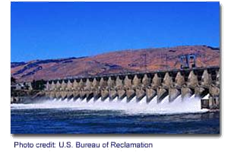 to turn.† The
turbine spins a generator to produce electricity. The electricity can then
travel over long distance electric lines to your home, to your school, to
factories and businesses.
to turn.† The
turbine spins a generator to produce electricity. The electricity can then
travel over long distance electric lines to your home, to your school, to
factories and businesses.
Hydro power today can be
found in the mountainous areas of states where there are lakes and reservoirs
and along rivers. The problem is that
some parts of the country are not mountainous or near rivers.†
Biomass
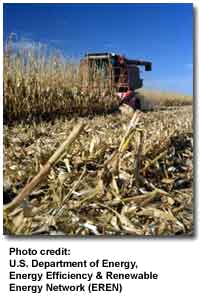 Biomass is matter usually thought of as garbage. Some
of it is just stuff lying around -- dead trees, tree branches, yard clippings,
left-over crops, wood chips, and bark and sawdust from lumber mills. It can
even include used tires and livestock manure.
Biomass is matter usually thought of as garbage. Some
of it is just stuff lying around -- dead trees, tree branches, yard clippings,
left-over crops, wood chips, and bark and sawdust from lumber mills. It can
even include used tires and livestock manure.
Your trash, paper products
that can't be recycled into other paper products, and other household waste are
normally sent to the dump. Your trash contains some types of biomass that can
be reused. Recycling biomass for fuel and other uses cuts down on the need for
"landfills" to hold garbage.
This stuff nobody seems to
want can be used to produce electricity, heat, compost material or fuels.
Composting material is decayed plant or food products mixed together in a
compost pile and spread to help plants grow.
In California more than 60
million tons of biomass is produced each year.†
Of this, five million tons is now burned to make electricity. This is
biomass from lumber mill wastes, urban wood waste, forest and agricultural
residues and other feed stocks.†† If all
60 million tons of biomass was used it could make close to 2,000
megawatts of electricity.† That's enough
energy to make electricity for about two million homes!
How does biomass work?
How biomass works is very simple.
The waste wood, tree branches and other scraps are gathered together in big
trucks. The trucks bring the waste from factories and from farms to a biomass
power plant. Here the biomass is dumped into huge containers. This is then fed
into a furnace where it is burned. The heat is used to boil water in the
boiler, and the energy in the steam is used to turn turbines and generators.
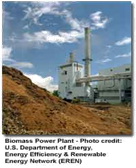 Biomass can also be tapped right at the landfill with
burning waste products. When garbage decomposes, it gives off methane gas.
You'll remember that natural gas is made up of methane. Pipelines are put into
the landfills and the methane gas can be collected. It is then used in power
plants to make electricity. This type of biomass is called landfill gas.
Biomass can also be tapped right at the landfill with
burning waste products. When garbage decomposes, it gives off methane gas.
You'll remember that natural gas is made up of methane. Pipelines are put into
the landfills and the methane gas can be collected. It is then used in power
plants to make electricity. This type of biomass is called landfill gas.
A similar thing can be done
at animal feed lots. In places where lots of animals are raised, the animals -
like cattle, cows and even chickens - produce manure. When manure decomposes,
it also gives off methane gas similar to garbage. This gas can be burned right
at the farm to make energy to run the farm.
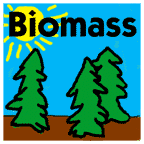 Using biomass does not add to global warming.† Plants use and store carbon dioxide (CO2)
when they grow. This is then released when the plant material is burned. Other
plants then use that released CO2 when they grow.† So using biomass closes this cycle of storing
carbon dioxide. Carbon dioxide is a gas that, when there's too much, can
contribute to the "greenhouse effect" and global warming.
Using biomass does not add to global warming.† Plants use and store carbon dioxide (CO2)
when they grow. This is then released when the plant material is burned. Other
plants then use that released CO2 when they grow.† So using biomass closes this cycle of storing
carbon dioxide. Carbon dioxide is a gas that, when there's too much, can
contribute to the "greenhouse effect" and global warming.
So, the use of biomass is environmentally
friendly because the biomass is reduced, recycled and then reused. It is also a
renewable
resource because plants to make biomass can be grown over and over.
Today, new ways of using
biomass are still being discovered. One way is to produce ethanol, a liquid
alcohol fuel. Ethanol can be used in special types of cars that are made for
using alcohol fuel instead of gasoline. The alcohol can also be combined with
gasoline. This reduces our dependence on oil - a non-renewable fossil fuel.
Wind Energy
Wind can be used
to do work. The kinetic energy of the wind can be changed into other forms of
energy, either mechanical energy or electrical energy.†† When a boat lifts a sail, it is using wind
energy to push it through the water. This is one form of work.

Farmers have been using wind energy for
many years to pump water from wells using windmills.
In Holland, windmills have been used for centuries
to pump water from low-lying areas.
Wind is also used to turn large grinding
stones to grind wheat or corn, just like a water wheel is turned by water
power.
 Today, the wind is also used to make
electricity.†† Blowing wind spins the
blades on a wind turbine -- just like a large toy pinwheel. The blades turn on
a shaft that turns a generator that makes electricity.
Today, the wind is also used to make
electricity.†† Blowing wind spins the
blades on a wind turbine -- just like a large toy pinwheel. The blades turn on
a shaft that turns a generator that makes electricity.
If the wind gets too high, the turbine has
a brake that will keep the blades from turning too fast and being damaged.
Wind is blowing in all areas of the
earth.† The only problem with wind is that it is not windy all the time.† In order for a wind turbine to work
efficiently, wind speeds usually must be above 12 to 14 miles per hour. If the
wind is blowing slower the turbines canít spin fast enough to generate any
electricity.†
The turbines usually produce about 50 to
300 kilowatts of electricity each. A 300 kilowatt (300,000 watts) wind turbine
could light up 3,000 light bulbs that use 100 watts!
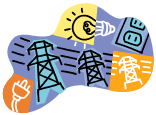 Turbines are grouped together in what are
called wind "farms."† These
wind farms are located mostly in the windiest areas of the state. About 11
percent of the entire world's wind-generated electricity is found in
California. Other countries that use a lot of wind energy are Denmark and
Germany.
Turbines are grouped together in what are
called wind "farms."† These
wind farms are located mostly in the windiest areas of the state. About 11
percent of the entire world's wind-generated electricity is found in
California. Other countries that use a lot of wind energy are Denmark and
Germany.
Once electricity is made by the turbine,
the electricity from the entire wind farm is collected together and sent
through a transformer. There the voltage is increased to send it long distances
over high power lines.
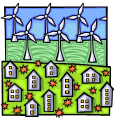 †
†


Geothermal
Geothermal Energy has ![[Earth's crust]](SCI160U15Renewable_Geothermal_image043.png) been around for as long as the Earth has existed. "Geo" means
earth, and "thermal" means heat. So, geothermal means earth-heat.
been around for as long as the Earth has existed. "Geo" means
earth, and "thermal" means heat. So, geothermal means earth-heat.
†
Have you ever cut a boiled
egg in half? The egg is similar to how the earth looks like inside. The yellow
yolk of the egg is like the core of the earth. The white part is the mantle of
the earth. And the thin shell of the egg, that would have surrounded the boiled
egg if you didn't peel it off, is like the earth's crust.
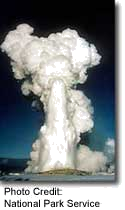 Below the crust of the earth, the top layer of the
mantle is a hot liquid rock called magma. The crust of the earth floats on this
liquid magma mantle. When magma breaks through the surface of the earth in a
volcano, it is called lava.
Below the crust of the earth, the top layer of the
mantle is a hot liquid rock called magma. The crust of the earth floats on this
liquid magma mantle. When magma breaks through the surface of the earth in a
volcano, it is called lava.
For every 100 meters you go
below ground, the temperature of the rock increases about 3 degrees Celsius. Or
for every 328 feet below ground, the temperature increases 5.4 degrees
Fahrenheit. So, if you went about 10,000 feet below ground, the temperature of
the rock would be hot enough to boil water.
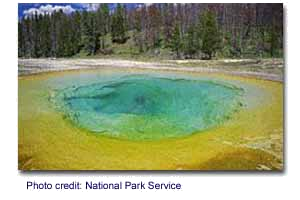
Deep under the surface, water
sometimes makes its way close to the hot rock and turns into boiling hot water
or into steam. The hot water can reach temperatures of more than 300 degrees
Fahrenheit (148 degrees Celsius). This is hotter than boiling water (212
degrees F / 100 degrees C). It doesn't turn into steam because it is not in
contact with the air. When this hot water comes up through a crack in the
earth, we call it a hot spring, like Emerald Pool at Yellowstone National Park.
Or, it sometimes explodes into the air as a geyser, like Old Faithful Geyser.
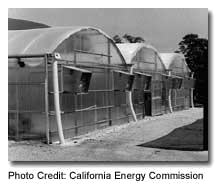
About 10,000 years ago,
Paleo-Indians used hot springs in North American for cooking. Areas around hot
springs were neutral zones. Warriors of fighting tribes would bathe together in
peace. Every major hot spring in the United States can be associated with
Native American tribes. California hot springs, like at the Geysers in the Napa
area, were important and sacred areas to tribes from that area. In other places
around the world, people used hot springs for rest and relaxation. The ancient
Romans built elaborate buildings to enjoy hot baths, and the Japanese have
enjoyed natural hot springs for centuries.
Geothermal Today†
Today, people use the
geo-thermally heated hot water in swimming pools and in health spas. Or, the
hot water from below the ground can warm buildings for growing plants.
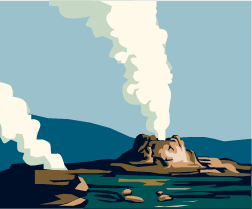 In San Bernardino, in Southern California, hot water
from below ground is used to heat buildings during the winter. The hot water
runs through miles of insulated pipes to dozens of public buildings. The City
Hall, animal shelters, retirement homes, state agencies, a hotel and convention
center are some of the buildings which are heated this way.
In San Bernardino, in Southern California, hot water
from below ground is used to heat buildings during the winter. The hot water
runs through miles of insulated pipes to dozens of public buildings. The City
Hall, animal shelters, retirement homes, state agencies, a hotel and convention
center are some of the buildings which are heated this way.
In the Country of Iceland,
many of the buildings and even swimming pools in the capital of Reykjavik
(RECK-yah-vick) and elsewhere are heated with geothermal hot water. The country
has at least 25 active volcanoes and many hot springs and geysers.
Geothermal Electricity
Hot water or steam from below
ground can also be used to make electricity in a geothermal power plant.† Some of the areas have so much steam and hot
water that it can be used to 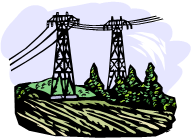 generate electricity. Holes are drilled into the
ground and pipes lowered into the hot water, like a drinking straw in a soda.
The hot steam or water comes up through these pipes from below ground.
generate electricity. Holes are drilled into the
ground and pipes lowered into the hot water, like a drinking straw in a soda.
The hot steam or water comes up through these pipes from below ground.
A geothermal power plant is
like in a regular power plant except that no fuel is burned to heat water into
steam. The steam or hot water in a geothermal power plant is heated by the
earth. It goes into a special turbine. The turbine blades spin and the shaft
from the turbine is connected to a generator to make electricity. The steam
then gets cooled off in a cooling tower.††
The cooled water can then be pumped back below ground to be reheated by
the earth.
Geothermal / Ground Source Heat
Pumps
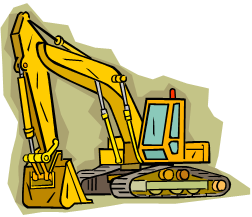 Though it gets much hotter as we go deep below ground,
the upper layer of the earth close to the surface is not very hot.
Though it gets much hotter as we go deep below ground,
the upper layer of the earth close to the surface is not very hot.
Almost everywhere across the entire planet,
the upper 10 feet below ground level stays the same temperature, between 50 and
60 degrees Fahrenheit (10 and 16 degrees C). If you've ever been in a basement
of a building or in a cavern below ground, the temperature of the area is
almost always cool.
A geothermal or ground source
heat pump system can use that constant temperature to heat or cool a building.
Pipes are buried in the ground near the building. Inside these pipes a fluid,
like the antifreeze in a car radiator, is circulated.
In winter, heat from the
warmer ground goes through a heat pump, which sends warm air into the home or
business. During hot weather, the process is reversed. Hot air from inside the
building goes through the heat pump and the heat is passed into the relatively
cooler ground. Heat removed during the summer can also be used to heat water.
Although we still rely
heavily on fossil fuels there are other options that we can use to reduce our
dependence on those fuels.† By looking at
the advantages and disadvantages of these alternatives we can make good
decisions to be sure that we have the energy we need for the future.†
ACITIVITY 1: Solar Símores
 Materials:††††
Every two people will need:
Materials:††††
Every two people will need:
4 graham crackers
16 mini marshmallows
2 plain milk chocolate candy
bars
8-by-11-inch glass baking pan
a clear glass lid for the
baking pan
1 thermometer
This is an outdoor
experiment: need to have a place in direct sunlight (no shade) and where
animals wonít come by to eat the ingredients or disturb the pan! Use your
thermometer to see what temperature it is outside. You need to do this
experiment when it is at least 85į F. If it isnít hot enough outside, wait for
a warmer day.
Activity
Directions
1. Put four graham crackers side by side in the bottom of
the glass baking pan.
2. Place a chocolate bar on top of two of the graham
crackers.
3. Put 8 mini-marshmallows on top of the other two graham
crackers.
4. Cover the baking pan with the clear glass lid.
5. Put the pan out in an area where it will get full
sunlightóno shade!
6. Let the pan just sit there until the chocolate bars
and marshmallows melt.
7. To make a SíMore, put one chocolate and one
marshmallow graham cracker together to make a sandwich. You should have two
sandwiches. Enjoy!
8. You might repeat this experiment, but this time try
lining the glass baking pan with aluminum foil and black construction paper.
See if the marshmallows and chocolate melt faster than they did in the plain
glass pan. If our hunch is right, and dark paper absorbs more sunlight and
heat, we should find out the SíMores melt faster than in the plain glass pan.